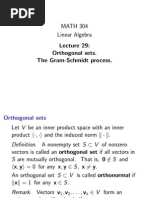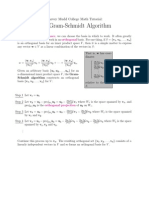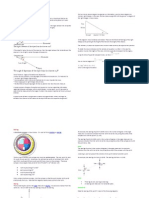Lin Alg Week 10 A
Uploaded by
Anthony JagdeoLin Alg Week 10 A
Uploaded by
Anthony JagdeoProof: Suppose that
1 v 1 + + n v n = 0.
Orthogonal or orthonormal bases are very useful but how do we
find them? We will show that every non-zero finite-dimensional real We must show that 1 = = n = 0. Fixing i, and taking the inner
inner product space has an orthonormal basis, by giving an algorithm product of both sides of this equation with v i , we obtain
for turning an initial non-orthonormal basis into an orthonormal one.
h0, v i i = h1 v 1 + + n v n , v i i
For this we will need
= 1 hv 1 , v i i + + n hv n , v i i
Proposition 4.12: If S = {v 1 , . . . , v n } is an orthogonal set of non-zero
= i hv i , v i i
elements in a real inner product space V , then the elements of S are
linearly independent. by the orthogonality of the v i s. But
h0, v i i = h0.0, v i i = 0h0, v i i = 0
and hv i , v i i =
6 0 and so i = 0 as required.
Anton Cox (City University London) AS2051/MA2602 Lecture 26 Autumn 2015 1/8 Anton Cox (City University London) AS2051/MA2602 Lecture 26 Autumn 2015 2/8
Step 1: Let
u1
Theorem 4.13: Every non-zero finite-dimensional real inner product v1 = .
ku 1 k
space has an orthonormal basis.
Then kv 1 k = 1 and this will be the first vector in our new basis.
For most of the proofs thus far in the module, we have not needed the
technical details of the proof in order to be able to apply the result. Step 2: Let
w 2 = u 2 hu 2 , v 1 iv 1 .
However this Theorem is different, as our proof will consist of a
description of the method used to construct an orthonormal basis. This Claim that w 2 is orthogonal to v 1 and is non-zero.
procedure is called the Gram-Schmidt process and will be very First we prove orthogonality: We have
important in what follows.
Proof: Let V be such a space, of dimension n say, and suppose that hw 2 , v 1 i = hu 2 hu 2 , v 1 iv 1 , v 1 i
u 1 , . . . u n is a basis of V . We will construct a new, orthonormal basis = hu 2 , v 1 i hu 2 , v 1 ihv 1 , v 1 i
for V from this. = hu 2 , v 1 i hu 2 , v 1 i = 0
as v 1 has norm 1.
Anton Cox (City University London) AS2051/MA2602 Lecture 26 Autumn 2015 3/8 Anton Cox (City University London) AS2051/MA2602 Lecture 26 Autumn 2015 4/8
We now proceed by induction. So suppose that we have already
Now suppose that w 2 = 0. Then constructed an orthonormal set v 1 , . . . , v k 1 ; we will show how to
construct v k .
u 2 hu 2 , v 1 iv 1 = 0. Step k: Let
1
kX
But this implies that w k = uk hu k , v i iv i .
u1
u 2 = hu 2 , v 1 i i=1
ku 1 k
Claim that w k is orthogonal to v 1 , . . . , v k 1 and is non-zero.
and hence that u 1 and u 2 are not independent (which is impossible).
First we prove orthogonality: For each 1 j < k we have
Now let
w2
v2 = 1
kX
kw 2 k hw k , v j i = hu k , v j i hu k , v i ihv i , v j i
which has norm 1, and so v 1 , v 2 form an orthonormal set. i=1
= hu k , v j i hu k , v j i = 0.
Anton Cox (City University London) AS2051/MA2602 Lecture 26 Autumn 2015 5/8 Anton Cox (City University London) AS2051/MA2602 Lecture 26 Autumn 2015 6/8
If w k = 0 then
1
kX
After n steps we get an orthonormal set v 1 , . . . , v n . By Proposition
uk hu k , v i iv i = 0.
4.12 these are linearly independent, and so they form a basis of V by
i=1
Corollary 1.32.
Each v i is a linear combination of u 1 , . . . , u i and so we will get
Example 4.14: Take R3 with the usual scalar product, and apply
1 X
kX i Gram-Schmidt to the basis
uk aij u i = 0
i=1 j=1 u 1 = (1, 1, 1) u 2 = (0, 1, 1) u 3 = (0, 0, 1).
for some aij , which contradicts the linear independence of the u i s.
Now let Example completed by hand in the lecture.
wk
vk =
kw k k
which has norm 1, and so v 1 , . . . , v k form an orthonormal set.
Anton Cox (City University London) AS2051/MA2602 Lecture 26 Autumn 2015 7/8 Anton Cox (City University London) AS2051/MA2602 Lecture 26 Autumn 2015 8/8
You might also like
- MATH 304 Linear Algebra Orthogonal Bases. The Gram-Schmidt Orthogonalization ProcessNo ratings yetMATH 304 Linear Algebra Orthogonal Bases. The Gram-Schmidt Orthogonalization Process15 pages
- MATH 304 Linear Algebra Orthogonal Bases. The Gram-Schmidt Orthogonalization ProcessNo ratings yetMATH 304 Linear Algebra Orthogonal Bases. The Gram-Schmidt Orthogonalization Process15 pages
- Gram Schmidt Orthogonalisation ( Unit 4 )No ratings yetGram Schmidt Orthogonalisation ( Unit 4 )6 pages
- MAS10009_Supplementary_Materials_Orthogonal_MatricesNo ratings yetMAS10009_Supplementary_Materials_Orthogonal_Matrices8 pages
- Further Linear Algebra. Chapter VI. Inner Product SpacesNo ratings yetFurther Linear Algebra. Chapter VI. Inner Product Spaces15 pages
- 1 Orthogonality and Orthonormality: Lecture 4: October 7, 2021No ratings yet1 Orthogonality and Orthonormality: Lecture 4: October 7, 20213 pages
- 9.5 - The Gram-Schmidt Orthogonalization Procedure - Mathematics LibreTextsNo ratings yet9.5 - The Gram-Schmidt Orthogonalization Procedure - Mathematics LibreTexts3 pages
- Lec8_Gram-Schmidt Orthogonalization, Projection Into a Subspace 4No ratings yetLec8_Gram-Schmidt Orthogonalization, Projection Into a Subspace 439 pages
- Linear Algebra (MA - 102) Lecture - 11 Inner Product Spaces Gram-Schmidt Orthogonalization ProcessNo ratings yetLinear Algebra (MA - 102) Lecture - 11 Inner Product Spaces Gram-Schmidt Orthogonalization Process24 pages
- Homework 8 Solutions: 6.2 - Gram-Schmidt Orthogonalization ProcessNo ratings yetHomework 8 Solutions: 6.2 - Gram-Schmidt Orthogonalization Process5 pages
- Capitulo 3(Student Mathematical Library 94) James Bisgard - Analysis and Linear Algebra_ The Singular Value Decomposition and Applications-American Mathematical Society (2021)No ratings yetCapitulo 3(Student Mathematical Library 94) James Bisgard - Analysis and Linear Algebra_ The Singular Value Decomposition and Applications-American Mathematical Society (2021)38 pages
- Section 6.1 - Inner Products and Norms: M×N I, J I, JNo ratings yetSection 6.1 - Inner Products and Norms: M×N I, J I, J16 pages
- 3.4 Orthogonal Bases and Gram-Schmidt (2)No ratings yet3.4 Orthogonal Bases and Gram-Schmidt (2)22 pages
- Mensuration: SSC CGL 2018 Tier 1 All QuestionsNo ratings yetMensuration: SSC CGL 2018 Tier 1 All Questions11 pages
- Department of Education: Third Periodical Test in Mathematics 6 Table of SpecificationNo ratings yetDepartment of Education: Third Periodical Test in Mathematics 6 Table of Specification6 pages
- Vector - Top 500 Question Bank For JEE Main by MathonGo PDFNo ratings yetVector - Top 500 Question Bank For JEE Main by MathonGo PDF18 pages
- SYLLABUS Teaching Math in The Primary SPEC 108 BEED 2 2023 2024No ratings yetSYLLABUS Teaching Math in The Primary SPEC 108 BEED 2 2023 20248 pages
- Course Structure Class - X: Units Unit Name MarksNo ratings yetCourse Structure Class - X: Units Unit Name Marks5 pages
- Mathematics T Trial P2 STPM 2014 SABS Kuantan Mark SchemeNo ratings yetMathematics T Trial P2 STPM 2014 SABS Kuantan Mark Scheme9 pages
- Angles of Elevation and Depression, Bearings Notes100% (2)Angles of Elevation and Depression, Bearings Notes4 pages
- Exercise 10.3 (Solutions) : Question # 1No ratings yetExercise 10.3 (Solutions) : Question # 17 pages
- Gujarat Technological University: Mechanical Engineering (19) SUBJECT CODE: 2161903No ratings yetGujarat Technological University: Mechanical Engineering (19) SUBJECT CODE: 21619033 pages
- Design Calculations For Pressure VesselsNo ratings yetDesign Calculations For Pressure Vessels28 pages

























































































